UpperCut is the first dedicated project presenting Thai cannabis culture to the world directly from…
|
Getting your Trinity Audio player ready...
|
1. Introduction and Background
The visual appeal of a clean, white ash has long been used as a heuristic among cannabis smokers to judge the quality of their product. Many consumers assert that if a joint burns down to a powdery white ash, the cannabis must have been properly cured, flushed, and handled with care. Conversely, dark or black ash is often dismissed as evidence of residual moisture, excess nutrients, or poor combustion. However, as cannabis cultivation has evolved and scientific inquiry has begun to shed light on combustion chemistry, it has become clear that the relationship between ash color and cannabis quality is complex. This article aims to provide a detailed exploration of the factors that contribute to white ash formation, drawing on combustion science, chemical analysis, historical context, and industry perspectives.
2. Combustion and Ash Formation in Cannabis
2.1 Fundamentals of Combustion
Combustion is a chemical reaction in which a substance reacts with oxygen to produce heat, light, and byproducts. When cannabis is burned, its organic constituents—such as carbohydrates, lipids, proteins, and terpenes—undergo oxidation. The process converts much of the plant’s carbon into carbon dioxide (CO₂) and water vapor. What remains is a residue of non-combustible inorganic materials, commonly referred to as ash.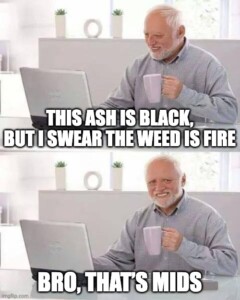
2.2 Inorganic vs. Organic Residues
Ash is primarily composed of inorganic mineral compounds that were originally present in the plant. Elements such as potassium (K), calcium (Ca), magnesium (Mg), sodium (Na), silicon (Si), and phosphorus (P) are typically found in cannabis. During combustion, these elements combine with oxygen to form oxides and carbonates. The resultant compounds—such as potassium carbonate (K₂CO₃), calcium carbonate (CaCO₃), and similar derivatives—are white in appearance if the combustion is complete. In contrast, if the combustion is incomplete due to insufficient heat or oxygen, carbon remains in the residue, imparting a darker, black color to the ash.3. Chemical Compounds Responsible for White Ash
3.1 Formation of Mineral Oxides and Carbonates
The white color observed in ash is largely due to the formation of crystalline or amorphous inorganic compounds during high-temperature combustion. When cannabis burns at high temperatures (typically above 450 °C), the organic carbon is volatilized. The inorganic minerals—absorbed from the soil or nutrient solutions—then oxidize to form compounds such as:- Potassium carbonate (K₂CO₃) or potassium oxide (K₂O)
- Calcium carbonate (CaCO₃) or calcium oxide (CaO)
- Magnesium oxide (MgO)
- Sodium compounds such as sodium carbonate (Na₂CO₃)
3.2 The Role of Burn Temperature
The combustion temperature is a critical factor in determining whether ash will be white. At temperatures below 450 °C, incomplete combustion can leave residual carbon in the ash, resulting in darker coloration. As the temperature increases, the carbon volatilizes, leaving behind predominantly inorganic mineral compounds. Studies on combustion in wildfires and other plant materials have shown that as burn temperature rises, the concentration of organic nitrogen and carbon decreases, and the ash color transitions from black to gray to white [3].
4. Residues in Cannabis Ash: Composition and Analysis
4.1 Inorganic Residues in Ash
After combustion, the ash left behind from cannabis is composed mainly of inorganic residues that do not burn. These include the aforementioned oxides and carbonates of potassium, calcium, magnesium, and sodium. The exact composition of the ash will vary depending on the cannabis strain, the nutrients available during growth, and the curing process.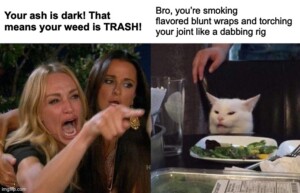
4.2 Impact of Curing and Moisture Content
The curing and drying process is critical for ensuring that cannabis burns evenly. Proper curing reduces the moisture content and degrades chlorophyll and other organic compounds that could interfere with combustion. When cannabis is well cured and dry, it tends to burn more completely, which in turn produces lighter, whiter ash.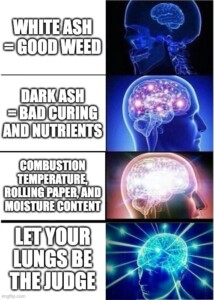
4.3 The Flushing Debate
Many growers advocate for the practice of “flushing”—withholding nutrients in the final weeks before harvest—to remove residual fertilizers from the plant. The theory is that this process will lead to cleaner, smoother smoke and a white ash. However, research (such as that discussed in the Dutch Passion article [2]) has cast doubt on the effectiveness of flushing in significantly reducing the mineral content in buds. In many cases, the elemental composition remains largely unchanged, meaning that the color of the ash is more a function of the plant’s inherent mineral uptake and the curing process than of any pre-harvest nutrient flushing.5. Historical Perspectives on the White Ash Myth
5.1 Origins of the White Ash Belief
The association of white ash with high-quality cannabis has its roots in decades of cannabis smoking culture. Early cannabis consumers, operating largely without laboratory analyses, relied on visual cues to assess quality. A white, powdery ash was interpreted as evidence that the plant had been properly cured and that it burned completely. This visual cue became a shorthand for quality and was passed down as conventional wisdom within the cannabis community. Historical anecdotes suggest that early dispensaries and budtenders in regions like California began to emphasize white ash as a key quality marker. Over time, this concept became part of cannabis lore, even though subsequent scientific investigation has shown that ash color is influenced by a myriad of factors, not all of which correlate directly with quality.5.2 Influence of the Tobacco Industry
The tobacco industry has a long history of engineering products to produce white ash. As reported by Cannabis Business Times [3], tobacco manufacturers added chemical additives such as nitrates, magnesium, and calcium salts to ensure that cigarettes burned at high temperatures, yielding a white ash. This practice was partly driven by marketing needs, as white ash became synonymous with a “clean” burn. The success of these techniques in tobacco likely influenced the early cannabis community, leading many to assume that similar characteristics would indicate quality in cannabis.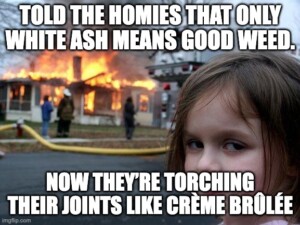
6. Influence of Cultivation Practices on Ash Color
6.1 Nutrient Management and Flushing Practices
Many modern cannabis cultivators believe that careful nutrient management—including the practice of flushing—is essential for producing a high-quality, clean-burning product. The rationale is that by withholding nutrients in the final stages of growth, any residual fertilizers that could interfere with combustion are washed out, resulting in a smoother smoke and whiter ash.
6.2 The Role of Biased Claims from Nutrient Manufacturers
Some nutrient manufacturers and cannabis brands claim that their products lead to a cleaner, whiter ash when the cannabis is combusted. These claims are often based on internal studies or anecdotal evidence and should be treated with caution because of potential commercial bias. It is important for growers and consumers to critically assess such statements and rely on independent research where available.6.3 Curing, Drying, and Their Impact on Ash
Proper curing and drying are vital components of cannabis production that affect combustion properties. A well-cured bud will have reduced moisture content, enabling more complete combustion and resulting in a finer, whiter ash. Conversely, inadequate curing may leave behind excess moisture and organic residues that cause incomplete combustion and darker ash.7. The Influence of Rolling Papers and Consumption Methods
7.1 Rolling Paper Composition and Its Effects
Not only do cultivation practices affect ash color, but the materials used in rolling cannabis joints can also have a significant impact. Rolling papers come in various compositions—ranging from traditional tree pulp papers to unbleached hemp-based papers. The additives or bleaching agents used in some papers can alter the combustion process.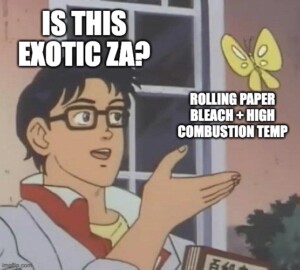
7.2 Joint Construction and Combustion Efficiency
The manner in which a joint is rolled also affects its combustion properties. A finely ground, evenly rolled joint allows for a consistent burn and optimal oxygen flow, which promotes complete combustion. In contrast, a loosely or unevenly rolled joint can burn unevenly, resulting in patches of incomplete combustion that manifest as darker ash. Therefore, when evaluating ash color as an indicator of cannabis quality, it is important to consider not only the plant material itself but also the rolling paper and rolling technique.8. Comparison with Tobacco Ash: Lessons and Limitations
8.1 Why Cigarettes Burn White
Cigarettes have been engineered for decades to produce a uniform, white ash. As noted in the Cannabis Business Times article [3], tobacco manufacturers use chemical additives such as potassium nitrate and calcium salts in both the tobacco blend and the paper to promote a high-temperature, complete combustion process. These additives ensure that the residual ash is composed almost entirely of inorganic minerals, which are white in color. This approach has been highly successful in creating a consistent smoking experience and has led many consumers to associate white ash with a “clean” burn.8.2 Can the Tobacco Model Be Applied to Cannabis?
It is tempting to assume that the principles behind tobacco combustion should also apply to cannabis. However, there are important differences between the two:- Processing and Additives: Unlike tobacco, cannabis is typically consumed without engineered additives that control combustion. Cannabis relies on its natural mineral content and cultivation practices.
- Plant Composition: Cannabis contains a wide array of organic compounds—such as cannabinoids, terpenes, and flavonoids—that affect combustion. The resin content and moisture level in cannabis can lead to variability in ash color even among high-quality buds.
- Consumption Methods: Tobacco is primarily consumed in a standardized form (cigarettes), whereas cannabis is consumed in various forms (joints, pipes, bongs, vaporizers), each affecting combustion differently.
9. Influence of California Brands and Industry Figures on the White Ash Hype
9.1 The Californian Cannabis Scene
California has long been at the forefront of cannabis innovation, both in terms of cultivation techniques and market influence. Influential brands and industry figures in California have played a key role in propagating the myth that white ash is synonymous with superior cannabis.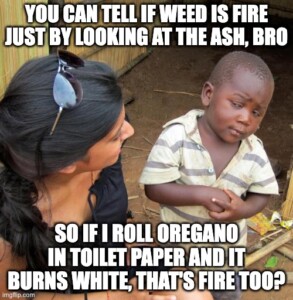
9.2 Anecdotal Evidence and Expert Opinions
Several respected figures in the cannabis industry have shared their personal experiences regarding ash color. For example, industry veterans have noted that early in their careers they would chase the “perfect white ash” as a sign of quality. Over time, however, they discovered that even premium cannabis can sometimes burn with a darker ash if combustion conditions are not optimal.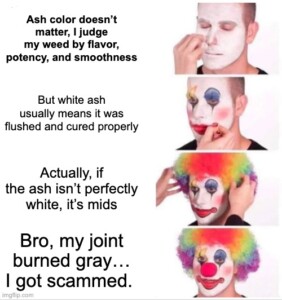
“I always thought that a pure white ash meant I’d grown the best weed. But I eventually learned that factors such as how evenly you roll your joint and the moisture level of the bud can affect the ash. Even top-shelf cannabis can leave a grayish ash if it isn’t burned evenly.”(source available in various online forums and discussed in Cannabis Business Times [3]). Such anecdotal evidence is widely shared on industry platforms and underscores that white ash should not be the sole measure of quality. Additionally, panel discussions and articles in publications like High Times have criticized “cheap schemes and big tobacco tricks” used to manufacture the appearance of quality by manipulating ash color [3]. These critiques have contributed to a more critical view among California consumers, even as some marketing materials continue to tout white ash as a quality marker.
10. Anecdotal Evidence from Respected Cannabis Industry Voices
Anecdotal evidence from well-known cannabis experts and cultivators provides valuable context to the white ash debate. Although scientific data on cannabis combustion is still emerging, the experiences of respected industry figures offer practical insights:- Steve DeAngelo – A prominent cannabis activist and entrepreneur, DeAngelo has often remarked that while white ash can indicate a smooth, complete burn, it should not be the sole indicator of cannabis quality. He emphasizes that aroma, flavor, and overall user experience are equally, if not more, important. (source).
- Dr. Ethan Nadelmann – A researcher and advocate for evidence-based cannabis policies, Dr. Nadelmann has stated that “the appearance of ash is influenced by many factors, including moisture content and rolling technique. A white ash might simply reflect a high burn temperature rather than overall quality.” (source).
- Industry Forums and Long-time Cultivators – Numerous discussions on forums such as r/TheOCS and cannabis cultivation blogs reiterate that even excellent, well-cured cannabis can sometimes burn with darker ash due to environmental and technical factors during smoking. These accounts consistently warn against overreliance on ash color as a quality metric. (source).
11. Critical Analysis: Is White Ash a Reliable Indicator?
The question remains: can white ash serve as a definitive marker of cannabis quality? A careful review of the scientific literature and anecdotal reports suggests that the answer is complex.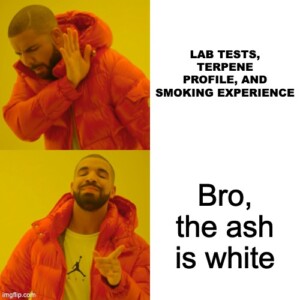
- Rolling Technique and Paper: As discussed earlier, the type of rolling paper and the manner in which a joint is rolled can alter combustion efficiency.
- Moisture Content: Even slight variations in curing and drying can lead to incomplete combustion, leaving darker ash.
- Nutrient Residues: Although flushing is purported to remove excess nutrients, research indicates that the elemental composition of the bud remains relatively constant, regardless of flushing practices.
- Strain and Genetics: Different cannabis strains accumulate minerals differently, which can result in variable ash color even when other quality parameters are high.
12. Future Directions and Conclusion
As the cannabis industry continues to mature and as scientific research delves deeper into combustion dynamics and plant chemistry, our understanding of what constitutes quality in cannabis will become increasingly nuanced. While the white ash myth persists as a popular belief among many consumers, evidence suggests that it is merely one of many indicators—and not necessarily the most reliable one. Future studies should aim to quantify the precise relationship between curing practices, nutrient management, and combustion characteristics. Moreover, controlled experiments comparing different rolling papers and joint construction methods could provide further clarity on how these factors influence ash color. In conclusion, while white ash may provide a useful heuristic for gauging the dryness and combustion efficiency of cannabis, it should not be relied upon in isolation to determine quality. Both growers and consumers are encouraged to adopt a holistic approach—taking into account chemical profiles, sensory attributes, and production practices—to truly assess the excellence of their cannabis. As the industry evolves, dispelling outdated stereotypes like the white ash myth will be essential to making informed decisions and advancing cannabis science. Ultimately, the goal is to ensure that quality is measured by a comprehensive set of metrics rather than by a single, potentially misleading visual cue.References
- [1] “White Ash vs Black Ash,” Cannabis Business Times, 10 months ago. [Online]. Available: https://www.cannabisbusinesstimes.com/columns/guest-column/article/15699165/white-ash-vs-black-ash.
- [2] “Cannabis white ash: a flushing theory debunked,” Dutch Passion. [Online]. Available: https://dutch-passion.com/en/blog/cannabis-white-ash-a-flushing-theory-debunked-n1196.
- [3] “Cheap schemes and big tobacco tricks: the recipe for white ash,” High Times, published 3.9 years ago. [Online]. Available: https://hightimes.com/culture/cheap-schemes-and-big-tobacco-tricks-the-recipe-for-white-ash/.
- [4] “White vs Black Cannabis Ash: Does Colour Matter?” Royal Queen Seeds, 2024. [Online]. Available: https://www.royalqueenseeds.com/blog-white-vs-black-cannabis-ash-does-colour-matter-n1630.
- [5] “White Ash: Flushing Out Old Stereotypes,” Leaf Magazines, March 12, 2021. [Online]. Available: https://leafmagazines.com/learn/white-ash-flushing-out-old-stereotypes/.
- [6] Reddit discussion on ash composition, r/chemistry. [Online]. Available: https://www.reddit.com/r/chemistry/comments/116loxs/after_the_carbon_burns_off_what_makes_up_the/.
- [7] Reddit thread on white vs. black ash in cannabis, r/TheOCS. [Online]. Available: https://www.reddit.com/r/TheOCS/comments/qib2qz/white_ash_vs_black_ash_isnt_what_you_think_it_is/.
- [8] “White Ash vs Black Ash Weed,” Claybourne Co. Cannabis, 5 months ago. [Online]. Available: https://www.claybourneco.com/blog/white-ash-vs-black-ash-weed.
Related Posts
-
UpperCut - Documenting Thai Cannabis Culture
-
Medical cannabis welcomes cheaper supplies
A cheaper supply of the goods people use to treat their pain and illnesses resulted…
-
Clarification of cannabis rules
Today, June 18, Public Relations on Cannabis posted on Facebook that the Director-General of the…

Nick High
Nick is a cannabis enthusiast and software developer. He is writing articles too, but only every so often. Follow him on Instagram

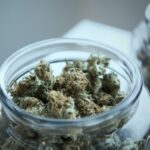

One reply on “White Ash and Cannabis: Chemistry, Culture, Quality and “Trust me, Bro””
Great post there. absolutely needed.